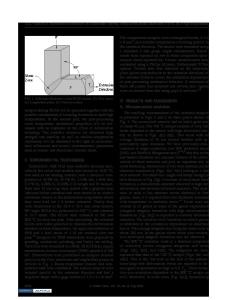Deformation Twinning in Nb-Microalloyed Fe-Mn-C-Al Twinning-Induced Plasticity Steel
- PDF / 1,920,478 Bytes
- 8 Pages / 593.972 x 792 pts Page_size
- 32 Downloads / 685 Views
JMEPEG DOI: 10.1007/s11665-017-2898-x
Deformation Twinning in Nb-Microalloyed Fe-Mn-C-Al Twinning-Induced Plasticity Steel Eui Pyo Kwon, Dae Young Kim, and Hyun Kyeong Park (Submitted December 19, 2016; in revised form May 15, 2017) Work hardening and deformation twinning in microalloyed Fe-Mn-C-Al twinning-induced plasticity (TWIP) steel with Nb were investigated in this study, and it was found that the addition of Nb affected the work-hardening behavior of TWIP steel. Moreover, the quantitative characterization of twinning was performed on the deformed microstructure by electron backscattering diffraction analysis, and the results indicate that the addition of Nb causes a reduction in twinning kinetics. The decrease in deformation twinning in TWIP steel with added Nb can be attributed to the effect of fine grain, dislocations in nonrecrystallized grains, and the formation of twins on a particular grain orientation. Keywords
deformation twinning, microalloying, microstructure, twinning-induced plasticity steel, work-hardening rate
1. Introduction Twinning-induced plasticity (TWIP) steels are attractive for application in automotive manufacture due to their extraordinary strength-ductility combination and extremely large workhardening rate (Ref 1-3). Twinning is a major underlying deformation mechanism along with dislocation slip, which contributes to work hardening during the plastic deformation of TWIP steels. With the progressive formation of twins, the original grains are subdivided by the newly formed twin lamella, thus reducing the dislocation mean free path and resulting in a high work-hardening rate. This hardening phenomenon is called the ‘‘dynamic Hall-Petch effect’’ (Ref 3, 4). Stacking fault energy (SFE) is an important parameter affecting twinning behavior and mechanical properties of TWIP steels, and it has been reported that the SFE of about 20-50 mJ/ m2 is required to obtain TWIP effect (Ref 5). Deformation twinning in TWIP steel is influenced by chemical composition; for example, Fe-Mn-C and Fe-Mn-Si-Al TWIP steel deformed under the same conditions exhibit different work-hardening rates due to different deformation twinning behavior, and deformation twins in Fe-Mn-C TWIP steel have been found to be much finer than those in Fe-Mn-SiAl TWIP steel (Ref 4). Jin et al. investigated the effect of Al addition on the deformation behavior of Fe-Mn-C-(0-2)Al TWIP steel (Ref 6), and revealed that the addition of Al increases yield stress and uniform elongation but decreases the work-hardening rate due to slow deformation twinning caused Eui Pyo Kwon, Carbon and Light Materials Application R&D Group, Korea Institute of Industrial Technology, Jeonju 54853, Korea; Dae Young Kim, Carbon and Light Materials Application R&D Group, Korea Institute of Industrial Technology, Jeonju 54853, Korea and Department of Metallurgical Engineering, Chonbuk National University, Jeonju 54896, Korea; and Hyun Kyeong Park, R&D Center, Donghae Metal Co., Ltd, Wanju 55323, Korea. Contact e-mail: [email protected].
Journal of Materi
Data Loading...











